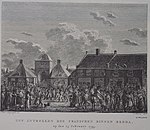Siege of Breda (1813)
1813 in the First French EmpireConflicts in 1813Events in BredaHistory of BredaHistory of North Brabant ... and 3 more
Sieges involving FranceSieges involving the NetherlandsSieges of the Napoleonic Wars
The siege of Breda took place from 19 to 22 December 1813 and was a small yet important engagement between French and allied troops in the Liberation Wars. Breda was abandoned by its garrison early in December and occupied by a Russian force. With Breda being the strategic link between the French garrisons of Gorinchem and Antwerp, and to hold control over the main road between Breda and Antwerp, the French began a counterattack. Meanwhile, Allied reinforcements were underway. After a scramble for the town and a three-day siege, the French withdrew back to Antwerp, and Breda became a distribution point for Allied troops and supplies.
Excerpt from the Wikipedia article Siege of Breda (1813) (License: CC BY-SA 3.0, Authors).Siege of Breda (1813)
Wilhelminasingel, Breda
Geographical coordinates (GPS) Address Nearby Places Show on map
Geographical coordinates (GPS)
| Latitude | Longitude |
|---|---|
| N 51.583333055556 ° | E 4.7833330555556 ° |
Address
Wilhelminasingel
Wilhelminasingel
4818 AC Breda
North Brabant, Netherlands
Open on Google Maps









